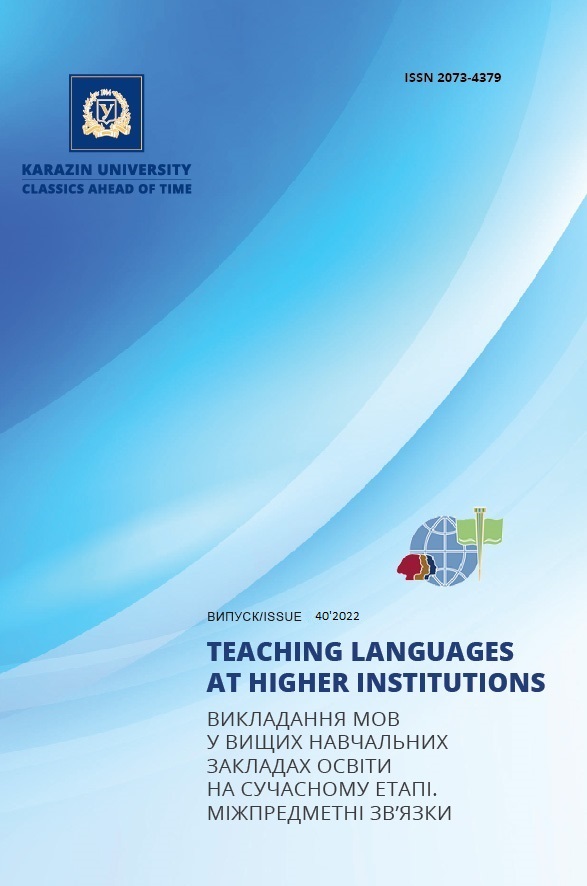Audiovisual teaching aids in the formation process of foreign language communicative competence
Abstract
The modern visually-oriented world is the world of real and virtual possibilities due to the application of information technologies. Therefore, television and the Internet are used not only for entertainment but also for educational purposes in all the spheres of human activity including education.
In didactics, audiovisuals play an important role in mastering foreign languages. The appropriateness of their use in the educational process is stipulated by their implementation facilitating all general didactic learning principles – activity, consciousness, consistency, and visualization as well. Audio and video materials are aimed at improving the perception efficiency of the program material, checking the level of its assimilation, and mastering the abilities and practical skills for application of the acquired knowledge. The aim of our analysis was an attempt to define the most basic principles for the formation of competence in a foreign language in students from non-language institutions of higher education based on the use of audiovisual teaching aids.
During the study, the authors conducted an analysis and synthesis of the best pedagogical practice, generalized their observations, and experimentally verified the validity of using audiovisual teaching aids in the formation of foreign language competence of foreign students of the preparatory department and the main stage of training (1st-4th year students), and 1st-2nd year Ukrainian students of Vinnytsia National Technical University.
The article clarifies the concept of foreign language competence. There have been analyzed the main methods of forming students’ foreign language competence based on the use of audio and video materials (phonetic recordings, texts recordings, audio lessons, podcasts, video clips, video films, electronic textbooks, online dictionaries, video conferences, virtual seminars, telecommunication projects). The authors have substantiated theoretically and tested experimentally the effectiveness of the use of audiovisual teaching aids and their influence on the formation of speech competence among Ukrainian and foreign students. They have proved that while using audiovisuals in the classroom one should take into account the cognitive patterns of students’ learning activities, and their readiness to perceive and assimilate the learning material. It is also important to ensure an organic combination of specific audiovisuals with the teacher’s professional skills.
The creation of the foreign language communicative environment will help both optimize the training of future engineers of foreign language professional communication, and also form their professional communicative competence.
Downloads
References
Antoniv, O. and Pauchok, L. (2012). Ukrainska mova dlia inozemtsiv. Modulnyi kurs. (+CD) [Ukrainian language for foreigners. Module course]. K.: Inkos [in Ukrainian].
Antoniuk, S.M. (2003). Komunikatyvnyi metod vyvchennia movy [Communicative method of language learning]. Visnyk Tekhnolohichnoho universytetu Podillia [Herald of Technological University Podillia]. Khmelnytskyi, pp. 107–109 [in Ukrainian].
Bychkova, N.I. (1992). Typolohiia videofonohram dlia navchannia usnoho inshomovnoho spilkuvannia [Typology of digital-video recordings for teaching verbal foreign language communication]. Metodyka vykladannia inozemnykh mov [Methology of teaching foreign languages]. Kyiv: Osvita, 21, pp. 68–71 [in Ukrainian].
Bandler, R. and Hrynder, D. (2010). Bolshaia entsyklopediya NLP. Struktura mahii [A Big Encyclopaedia of Neuro-Linguistic approaching. The Structure of Magic]. SPb. [in Russian].
Burak, M. (2015). Yabluko: pidruchnyk z ukrainskoi movy yak inozemnoi (bazovyi riven) [Apple: a textbook on Ukrainian as a foreign language]. Lviv: Vydavnytstvo UKU [in Ukrainian].
Zozulia, I.Ye. and Stadnii, A.S. (2019). Vykorystannia onlain-resursiv ta mobilnykh dodatkiv u vyvchenni ukrainskoi movy yak inozemnoi [Using of Online resources and mobile applications in learning Ukrainian as a foreign language]. Mizhnatsionalna komunikatsiia – poliloh kultur (aktualni pytannia navchannia inozemtsiv): zbirnyk naukovykh prats [Interethnic communication – a polylogue of cultures (current issues of teaching foreigners): a collection of scientific papers]. Reva-Lievshakova, L.V. (ed.). Odesa: I.I. Mechnykov Odesa national university, pp. 110 –113 [in Ukrainian].
Komarova, N.I. (2004). Tekhnichni ta audiovizualni zasoby navchannia. Prohrama dlia studentiv humanitarnkhykh fakultetiv pedahohichnykh vuziv [Technical and audiovisual teaching aids. Program for students of humanities faculties department of pedagogical universities]. Moscow: MDPU [in Ukrainian].
Kosenko, Yu.H. Tvii uspikh [Your success] [online]. Available at: https://youtube.com/playlist?list=PL09jwrqzmWH6_20dOXAvnDmTLqhbU21I4 [Accessed 19 Feb. 2022] [in Ukrainian].
Leontieva, T.P. (1995). Dosvid i perspektyvy zastosuvannia video v navchanni inozemnykh mov [Experience and prospects of using video in foreign language teaching]. Netradytsiini metody navchannia inozemnykh mov u vuzi [Unconventional methods of teaching foreign languages in higher education]. Minsk, pp. 61– 74 [in Ukrainian].
Palinska, O. (2014). Krok 2 (riven B1). Ukrainska mova yak inozemna. Knyha dlia studenta [Step 2 (level B1). Ukrainian as a foreign language: a book for students]. Lviv: Lvivska politekhnika [in Ukrainian].
Palinska, O. and Turkevych, O. (2014). Krok 1. Ukrainska mova yak inozemna. Knyha dlia studenta (+CD-ROM) [Step 1. Ukrainian as a foreign language. A book for a student]. Lviv: Lvivska politekhnika [in Ukrainian].
Pantelieieva, O.O. and Malieieva, T.Ye. (2019). Formuvannia inshomovnoi komunikatyvnoi kompetentsii studentiv nemovnykh spetsialnostei [Formation of foreign language communicative competence of students of non-language specialties]. Dukhovnist osobystosti: metodolohiia, teoriia i praktyka [Spirituality of personality: methodology, theory and practice]. 1, pp 132–142 [in Ukrainian].
Riabokuchma, T.O. and Horbachenko, A.L. (2021). The use of authentic video materials in the process of foreign language learning to ensure effective mastering of listening skills by students of higher educational establishments. Scientific Journal of National Pedagogical Dragomanov University. Series 5. Pedagogical sciences: realities and prospects. Vyp. 79, Tom 2, pp. 90–94 [in Ukrainian]. DOI: https://doi.org/10.31392/NPU-nc.series5.2021.79.2.19.
Tarnopolskyi, O.B. and Kabanova, M.R. (2019). Metodyka vykladannia inozemnykh mov ta yikh aspektiv u vyshchii shkoli [Methods of teaching foreign languages and their aspects in higher education]. Dnipro: Universytet imeni Alfreda Nobelia [in Ukrainian].
Chertov, V.F., Rybnikova, M.A. (1995). Metodika prepodavaniya literatury [Methods of teaching literature]. In 2 parts. Part 1. Moscow: Prosveshchenye, Vlados, pp. 57–60 [in Russian].

